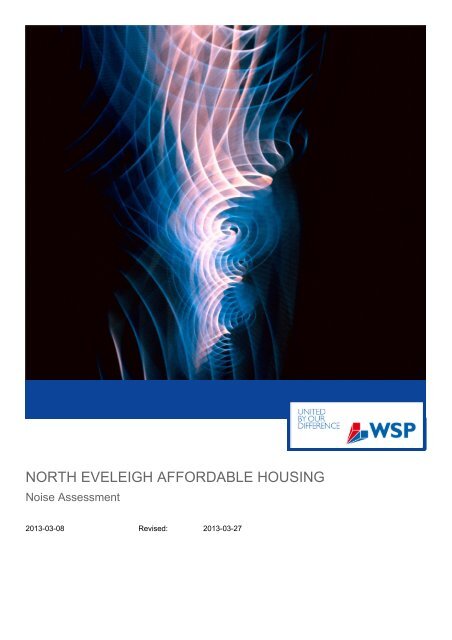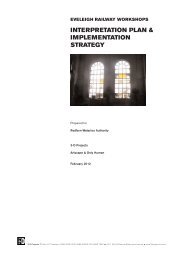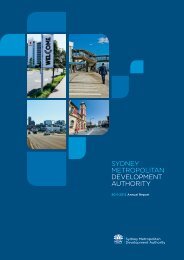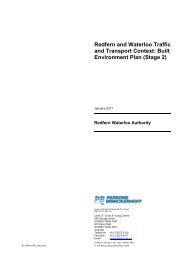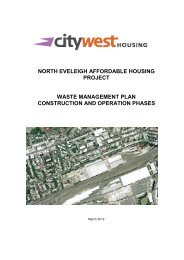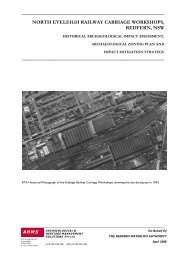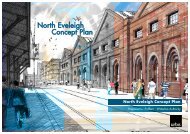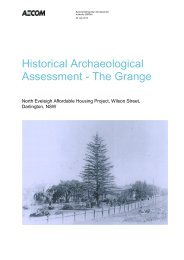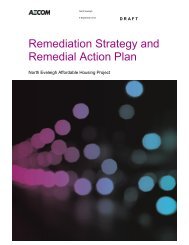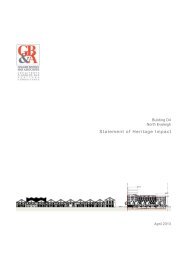Acoustic Report - SMDA
Acoustic Report - SMDA
Acoustic Report - SMDA
Create successful ePaper yourself
Turn your PDF publications into a flip-book with our unique Google optimized e-Paper software.
NORTH EVELEIGH AFFORDABLE HOUSING<br />
Noise Assessment<br />
2013-03-08 Revised: 2013-03-27
Quality Management<br />
Issue/revision Issue 1 Revision 1 Revision 2 Revision 3<br />
Remarks Issue Update<br />
Date 2013-03-08 2013-03-15 2013-03-27<br />
Prepared by D Rowe D Rowe D Rowe<br />
Updated from comments<br />
27/3/13<br />
Signature<br />
Checked by K Lloyd K Lloyd K Lloyd<br />
Signature<br />
Authorised by A Campbell A Campbell A Campbell<br />
Signature<br />
Project number ACG1301500 ACG1301500 ACG1301500<br />
<strong>Report</strong> number<br />
File reference<br />
Project number: ACG1301500<br />
Dated: 2013-03-08 2 | 20<br />
Revised: 2013-03-27
North Eveleigh Affordable Housing<br />
Noise Assessment<br />
2013-03-08<br />
Client<br />
City West Housing<br />
Consultant<br />
WSP <strong>Acoustic</strong>s<br />
Ground Floor, 41 McLaren Street<br />
North Sydney<br />
New South Wales 2060<br />
Australia<br />
Tel: (02) 8907 0900<br />
Fax: (02) 9957 4127<br />
<strong>Acoustic</strong>s@WSPGroup.com.au<br />
WSP Contacts<br />
Kezia Lloyd<br />
Deon Rowe<br />
3 | 20
Table of Contents<br />
1 Introduction ............................................................................... 5<br />
1.1 Site description ...................................................................... 5<br />
2 Criteria ...................................................................................... 6<br />
2.1 Noise Emissions .................................................................... 6<br />
2.1.1 Intrusiveness criteria ........................................................ 6<br />
2.1.2 Amenity criteria ................................................................ 6<br />
2.1.3 Project Specific criteria .................................................... 6<br />
2.2 Internal Noise Criteria ............................................................ 7<br />
2.2.1 Railcorp criteria ................................................................ 7<br />
2.3 Vibration Ingress .................................................................... 7<br />
2.4 Construction Noise & Vibration .............................................. 8<br />
2.4.1 Noise ............................................................................... 8<br />
2.4.2 Vibration .......................................................................... 9<br />
3 Prevailing Noise & Vibration Environment ............................... 10<br />
3.1 Background Noise & Vibration Survey ................................. 10<br />
3.2 Noise Results ...................................................................... 11<br />
3.3 Predicted Noise on Development Facades.......................... 11<br />
3.4 Vibration results ................................................................... 12<br />
4 Development Noise & Vibration Assessment .......................... 14<br />
4.1 Operational Noise Emission Limits ...................................... 14<br />
4.2 Development Façade Design .............................................. 14<br />
4.2.1 North façade .................................................................. 14<br />
4.2.2 South façade ................................................................. 14<br />
4.3 Ventilation Strategy ............................................................. 15<br />
4.4 Site Activity Noise ................................................................ 15<br />
4.5 Vibration Ingress .................................................................. 15<br />
5 Construction Noise & Vibration ............................................... 16<br />
5.1 Construction Methodology ................................................... 16<br />
5.2 Predicted Levels .................................................................. 16<br />
5.3 Assessment ......................................................................... 17<br />
5.3.1 Noise ............................................................................. 17<br />
5.3.2 Vibration ........................................................................ 18<br />
6 Summary ................................................................................. 19<br />
6.1 Noise and vibration ingress ................................................. 19<br />
6.2 Noise Emissions .................................................................. 19<br />
6.3 Construction noise & vibration ............................................. 19<br />
Project number: ACG1301500<br />
Dated: 2013-03-08 4 | 20<br />
Revised: 2013-03-27
1 Introduction<br />
WSP <strong>Acoustic</strong>s have been appointed to carry out a noise impact assessment for the North Eveleigh Affordable<br />
Housing Project located in Eveleigh, NSW.<br />
This noise impact assessment is required as part of the Development Application for the proposed<br />
development.<br />
This document provides information on the following:<br />
■<br />
■<br />
■<br />
■<br />
■<br />
Site description<br />
Description of relevant local noise criteria<br />
Noise survey results<br />
Noise and vibration assessment<br />
Construction noise and vibration assessment<br />
1.1 Site description<br />
The site for the proposed development is located on the northern side of Eveleigh, NSW. The site is bound by<br />
rail to the south and Wilson Street to the north; residential properties residing along the west and commercial<br />
buildings to the east.<br />
Figure 1-1 - Site Description<br />
5 | 20
2 Criteria<br />
The following documents are cited in the Director General’s Requirements (DGR’s) for the development and<br />
hence form the basis for this noise assessment:<br />
■<br />
■<br />
■<br />
■<br />
NSW Industrial Noise Policy 2000 (Environment Protection Authority EPA)<br />
Interim Construction Noise Guideline (Department of Environment and Climate Change)<br />
Rail infrastructure Corporation (Railcorp) - Interim Guidelines for Applicants – Consideration of Rail Noise<br />
and Vibration in the Planning Process<br />
Rail infrastructure Corporation (Railcorp) – Interim Guidelines for Councils – Consideration of Rail Noise<br />
and Vibration in the Planning Process<br />
2.1 Noise Emissions<br />
The industrial noise policy sets a project specific noise level applicable to each project. The more onerous of<br />
two types of criteria form the project specific noise levels. These two criteria are; one to account for intrusive<br />
noise and the other to protect the amenity of particular land uses.<br />
2.1.1 Intrusiveness criteria<br />
Table 2-1 - Intrusiveness criteria<br />
Period<br />
(Min L 90 + 5dB)<br />
Day - 7am to 6pm 49<br />
Eve – 6pm to 10pm 50<br />
Night – 10pm to 7am 49<br />
2.1.2 Amenity criteria<br />
Table 2-2 - Amenity criteria<br />
Receiver type<br />
Day<br />
(acceptable – maximum)<br />
Evening<br />
(acceptable – maximum)<br />
Night<br />
(acceptable – maximum)<br />
Commercial (when in use) 65 – 70 n/a n/a<br />
Residential Urban 60-65 50-55 45-50<br />
2.1.3 Project Specific criteria<br />
Based on most onerous levels for each period, the following criteria have been established as the project<br />
specific criteria.<br />
Table 2-3 - Project Specific criteria<br />
Receiver Type Day L Aeq(dBA) Evening L Aeq (dBA) Night L Aeq (dBA)<br />
Commercial (when in use) 65-70 (amenity criteria) n/a n/a<br />
Project number: ACG1301500<br />
Dated: 2013-03-08 6 | 20<br />
Revised: 2013-03-27
Receiver Type Day L Aeq(dBA) Evening L Aeq (dBA) Night L Aeq (dBA)<br />
Residential 49 (Intrusiveness criteria) 50 (amenity criteria) 49 (Intrusiveness criteria)<br />
2.2 Internal Noise Criteria<br />
2.2.1 Railcorp criteria<br />
As per the director generals conditions of consent C10, Railcorp’s guidelines have be established as the criteria<br />
to ensure the amenity of the buildings’ occupants/residents is protected. The following noise levels apply in any<br />
habitable room within the development. If noise levels were to exceed the windows/doors open criteria then the<br />
design of the ventilation should be such that occupants can leave the windows/doors closed, if they so desire.<br />
Table 2-4 - Railcorp - Interim guidelines for applicants - Airborne noise criteria<br />
Internal<br />
Space<br />
Time period<br />
Internal Noise Level<br />
L Aeq (1hour) (dBA)<br />
Windows/Doors<br />
closed<br />
Living and<br />
sleeping<br />
areas<br />
Day<br />
(7am to 10pm)<br />
Night<br />
(10pm -7am)<br />
40<br />
35<br />
Windows/Doors<br />
Open<br />
Living and<br />
sleeping<br />
areas<br />
Day<br />
(7am to 10pm)<br />
Night<br />
(10pm -7am)<br />
50<br />
45<br />
2.3 Vibration Ingress<br />
As per the Director General’s conditions of consent C10, Railcorp’s guidelines have been taken for the vibration<br />
ingress criteria.<br />
Within Railcorp’s guidance, the floor vibration levels in habitable rooms should comply with the criteria in British<br />
Standard 6472:1992 ‘Evaluation of Human Exposure to Vibration in Buildings (1Hz to 80 Hz)’.<br />
Intermittent vibration assessment (e.g. trains) is based on vibration dose value (VDV in m/s 1.75 ) or the r.m.s<br />
value of the frequency-weighted acceleration measured at the relevant places of interest.<br />
Table 2-5 British Standards 6472 – ‘Table 1’ Assessment of vibration<br />
Place and time<br />
Low probability of adverse<br />
comment<br />
(m.s -1.75 )<br />
Adverse comment<br />
possible<br />
(m.s -1.75 )<br />
Adverse comment<br />
probable<br />
(m.s -1.75 )<br />
Residential buildings<br />
16h day<br />
Residential buildings<br />
8h night<br />
0.2 to 0.4 0.4 to 0.8 0.8 to 1.6<br />
0.1 to 0.2 0.2 to 0.4 0.4 to 0.8<br />
7 | 20
2.4 Construction Noise & Vibration<br />
2.4.1 Noise<br />
The construction noise and vibration criteria have been taken from the Department of Environment and Climate<br />
Change ‘Interim Construction Noise Guideline:2009’.<br />
The rated background level (RBL), taken from the industrial noise policy shown in Table 3-3, is used to<br />
determine the management level for construction. As a guide the difference between the internal noise level<br />
and the external noise level is typically 10 dB with windows open for adequate ventilation.<br />
Figure 2-1 - Table 2 taken from the Interim Construction Noise Guideline (DECC) criteria<br />
Applying the RBL the following management levels have been derived and create the noise trigger levels for<br />
this project:<br />
Project number: ACG1301500<br />
Dated: 2013-03-08 8 | 20<br />
Revised: 2013-03-27
Table 2-6 – Management Trigger Levels at Residences:<br />
Management Trigger Levels<br />
Time of day:<br />
Standard Hours<br />
Monday to Friday:<br />
7am to 6pm<br />
Saturday:<br />
8am – 1pm<br />
Noise Affected<br />
LAeq(15min) dBA<br />
54 (RBL +10)<br />
Highly noise affected:<br />
75dB<br />
Outside standard hours 49 (RBL + 5) n/a<br />
Noise levels apply at the property boundary that is most exposed to construction noise, and at a height of 1.5m<br />
above ground level. If the property boundary is more than 30m from the residence, the location for measuring<br />
or predicting the noise level is at the most noise-affected point within 30m of the residence.<br />
2.4.2 Vibration<br />
The following figure is the only relevant vibration criteria in the Interim Construction Noise Guideline, as there<br />
will be no blasting onsite. This criterion concerns noise at residences caused by vibration during the hours of<br />
6pm to 7am. During these times it is expected that no significant vibration generating activities will be<br />
undertaken and therefore no ground-borne noise created.<br />
Figure 2-2 – Taken from Interim Construction Noise Guideline (DECC) Ground-borne noise criteria<br />
9 | 20
3 Prevailing Noise & Vibration Environment<br />
The site location for the prevailing noise measurement was on the northern side of Eveleigh, NSW. The survey<br />
was undertaken from 9:00hrs on the 18/02/2013 to 12:00hrs on the 19/02/2013. Consideration was taken to<br />
place the sound level meters in locations to best represent the existing noise levels of the area.<br />
The measurements of noise made during this visit were conducted in accordance with AS 1055 “<strong>Acoustic</strong>s—<br />
Description and Measurement of Environmental Noise”. Class 1 sound level meters as described by IEC<br />
61672-01:2002 were used.<br />
Metrological conditions for the duration of the noise survey were conducive to the measurement of<br />
environmental noise, being predominantly dry and little wind.<br />
Figure 3-1 - Measurement locations<br />
3.1 Background Noise & Vibration Survey<br />
Table 3-1 - Equipment used<br />
Equipment Description Manufacturer & Type No. Serial No. Calibration Due Date<br />
Sound Level Meter Norsonic – Nor140 1404791 21/10/2013<br />
Microphone Norsonic - 1227 14105 21/10/2013<br />
Preamplifier Norsonic – 1209 14105 21/10/2013<br />
Project number: ACG1301500<br />
Dated: 2013-03-08 10 | 20<br />
Revised: 2013-03-27
Equipment Description Manufacturer & Type No. Serial No. Calibration Due Date<br />
Vibration logging kit Svantek – Svan-958 14295 01/08/14<br />
Triaxial transducer SV 207 119 01/08/14<br />
Calibrator 1 Pulsar Model 105 55041 06/11/13<br />
Calibrator 2 BSWA Tech CA114 24/05/13<br />
The sound level meter was fitted with a windshield during the survey and was calibrated prior to, and on<br />
completion of the survey with the associated acoustic calibrator listed above. No significant calibration drift<br />
occurred.<br />
3.2 Noise Results<br />
Shown in Table 3-2 below are the summarised measured background noise levels adjusted as per Railcorp’s<br />
criteria time periods.<br />
Table 3-2 – Measured Noise Levels (Railcorp’s time periods)<br />
Background Noise level<br />
L 90 (dBA)<br />
Noise Level<br />
L Aeq (dBA)<br />
Day (7am – 10pm) 46.6 55.3<br />
Night (10pm – 7am) 46.2 52.4<br />
Shown in Table 3-3 below are the measured background noise levels and Rated Background Noise Levels<br />
(RBL) adjusted as per the Industrial Noise Policy’s time periods.<br />
Table 3-3 - Measured noise levels (INP time periods)<br />
Average Background<br />
Noise level<br />
L 90 (dBA)<br />
Rated Background Noise<br />
Level MIN.L 90 (dBA)<br />
Day (7am – 6pm) 46.1 44.3<br />
Eve (6pm – 10pm) 46.4 45<br />
Night (10pm – 7am) 45.9 43.6<br />
3.3 Predicted Noise on Development Facades<br />
Noise levels at the proposed building facades have been predicted based on the following parameters:<br />
■<br />
■<br />
Measured background noise levels<br />
Traffic flow data obtained from the Transport Assessment ‘City West Housing Pty Ltd North Eveleigh<br />
Affordable Housing Project (SSD_55708) January 2013.<br />
11 | 20
Table 3-4 - Predicted noise levels on development facades<br />
South Façade (dBA)<br />
North Façade (dBA)<br />
Day (7am – 10pm) 56 51<br />
Night (10pm – 7am) 55 44<br />
Figure 3-2- Predicted noise levels on development facades<br />
Note, the east and west facades fall within the ranges of the north and south facades.<br />
3.4 Vibration results<br />
The estimated VDV have been calculated for individual train pass-bys measured on site, these are as follows:<br />
Table 3-5 - Rail vibration results<br />
Sample Description eVDV Occurrence eVDV Day (18h) eVDV Night (8h)<br />
Test 1 Sample train - fast speed 0.00482 0.0294 0.02282<br />
Test 2 Sample train - fast speed 0.00187 0.01144 0.00885<br />
Project number: ACG1301500<br />
Dated: 2013-03-08 12 | 20<br />
Revised: 2013-03-27
Sample Description eVDV Occurrence eVDV Day (18h) eVDV Night (8h)<br />
Test 3 Sample train - medium speed 0.00564 0.03446 0.02667<br />
Test 4 Sample train - fast speed 0.00770 0.04706 0.03642<br />
Test 5 Sample train - fast speed 0.00577 0.03529 0.02731<br />
The eVDV day(18h) and night(8h) were calculated using flow data obtained from the Transport Assessment<br />
‘City West Housing Pty Ltd North Eveleigh Affordable Housing Project (SSD_55708) January 2013, as below:<br />
■ Day time train events: 1394<br />
■ Night time train events: 500<br />
The worst case test sample have been combined with the flow data to produce the day and night eVDV results<br />
for comparison with the criteria .these are shown below:<br />
Table 3-6 - Worst case vibration results<br />
Single eVDV Occurrence eVDV Day (18h) eVDV Night (8h)<br />
0.00770 0.04706 0.03642<br />
Comparing these with the criteria provided in Section 2.3 it is seen that these are below the required daytime<br />
and night time levels by a factor of 10. Therefore this is not considered an issue for this development.<br />
13 | 20
4 Development Noise & Vibration Assessment<br />
4.1 Operational Noise Emission Limits<br />
Plant noise emissions are subject to the project specific noise levels from the Industrial Noise Policy criteria in<br />
Section 2.1.3 and will be achieved through equipment selections and placement.<br />
Upon design development, if the predicted noise levels increase due to changes in equipment needs, acoustic<br />
mitigation measures may be necessary. These measures may include, but are not limited to;<br />
■<br />
■<br />
■<br />
■<br />
Attenuators<br />
Noise barriers<br />
<strong>Acoustic</strong> louvres<br />
<strong>Acoustic</strong> absorption<br />
4.2 Development Façade Design<br />
4.2.1 North façade<br />
To achieve the internal noise criteria is Section 2.2, the following minimum requirements are recommended:<br />
Glazing/glass doors<br />
Glazing areas along the North facade should have a minimum rating of rating of R w 32dB. The following table<br />
shows the reduction index spectrum for a R w 32dB glazing.<br />
Table 4-1 - North Façade - Recommended minimum glazing noise reduction<br />
North Façade - Glazing Noise Reduction Spectrum for a R w 32dB (dB) glazing<br />
Frequency 63 125 250 500 1K 2K 4K 8K<br />
R 17 21 25 31 35 30 36 36<br />
This can typically be achieved with min. 6mm well sealed single glazing. Should double glazing be required for<br />
thermal / sustainability / energy purposes, the minimum thickness of one of the panes should be at least 6mm.<br />
The reason for this is that at low frequency double glazing only performs as well as the thinnest layer of glass.<br />
Solid sections<br />
Solid sections of the façade are recommended to have a minimum rating of no less than the glazing<br />
specification, R w 32dB.<br />
4.2.2 South façade<br />
To achieve the internal noise criteria is Section 2.2, the following minimum requirements are recommended:<br />
Glazing<br />
Glazing areas along the South facade should have a minimum rating of R w 36dB. The following table shows the<br />
reduction index spectrum for a R w 36dB glazing.<br />
Project number: ACG1301500<br />
Dated: 2013-03-08 14 | 20<br />
Revised: 2013-03-27
Table 4-2 - South Façade – Recommended minimum glazing noise reduction<br />
South Façade - Glazing Noise Reduction Spectrum for a R w 36dB (dB) glazing<br />
Frequency 63 125 250 500 1K 2K 4K 8K<br />
R 25 26 28 34 36 38 44 44<br />
This can typically be achieved with min. 10mm well sealed single glazing. Should double glazing be required for<br />
thermal / sustainability / energy purposes, the minimum thickness of one of the panes should be at least 10mm.<br />
The reason for this is that at low frequency double glazing only performs as well as the thinnest layer of glass.<br />
Solid sections<br />
Solid sections of the façade are recommended to have a minimum rating of no less than the glazing<br />
specification, R w 36dB.<br />
Doors<br />
Along the south the doors form part of the external skin of the façade and therefore should have a minimum<br />
rating of R w 30dB.<br />
4.3 Ventilation Strategy<br />
Natural ventilation throughout the development is the proposed strategy. The predictions are based on<br />
openings providing a 5dBA noise reduction from outside to inside. This is considered a conservative estimate.<br />
Note that with a natural ventilation strategy employed, a 10 dB relaxation in noise criteria applies as per Section<br />
2.2.1.<br />
Daytime:<br />
Cross-flow ventilation is provided through openings on the north and/or south.<br />
Night-time:<br />
Ventilation throughout the unit is provided from openings on the north and/or east/west façades ensuring that<br />
opening sizes to each space meet the Building Code of Australia ventilation requirements. This allows the<br />
occupants to have the openings on the south closed during the night time and therefore preventing the noise<br />
levels exceeding the criteria.<br />
With the above strategy in place the internal noise criteria in Section 2.2.1 is achievable.<br />
4.4 Site Activity Noise<br />
There are currently no commercial operations nearby; therefore the traffic noise will be suitably mitigated by the<br />
glass provisions provided in the above sections. However, it is a possibility that an increase in nearby<br />
commercial operations with produce an increase in site activity noise. To mitigate this increase the north façade<br />
glazing requirements could be specified to match the south façade requirements.<br />
4.5 Vibration Ingress<br />
Vibration levels are a factor of 10 below the criteria and as such there will be no adverse effects caused from<br />
rail vibration.<br />
15 | 20
5 Construction Noise & Vibration<br />
The following is an outline assessment provided for information at this stage. A detailed assessment will need<br />
to be undertaken once the main contractor is appointed and additional detailed construction methods are<br />
known.<br />
5.1 Construction Methodology<br />
Piling is expected to be carried out along the west boundary and excavations along the other three boundaries.<br />
It is assumed that 1 piling location and 2 excavators will be working at the same time and therefore the noise<br />
predictions are based on the following equipment and observations:<br />
Activity on site:<br />
■<br />
■<br />
1 x Large piling rig (along the west boundary)<br />
2 x Tracked excavator (various locations)<br />
No activity on site:<br />
■<br />
Existing noise from general activity in the area<br />
5.2 Predicted Levels<br />
A computer model of the site and expected construction activity has been produced. This has taken into<br />
account the heights of the existing buildings and site topography.<br />
Table 5-1 - Noise Receivers location<br />
Project number: ACG1301500<br />
Dated: 2013-03-08 16 | 20<br />
Revised: 2013-03-27
Table 5-2 - Predicted site activity noise levels<br />
Predicted construction noise levels<br />
Receiver No site construction activity (dBA) Construction activity on site (dBA)<br />
Residential 1 60 61<br />
Residential 2 53 65<br />
Residential 3 50 64<br />
Commercial 1 53 61<br />
Figure 5-1 - Construction activity on site - Noise map<br />
5.3 Assessment<br />
5.3.1 Noise<br />
Comparing the predicted noise levels of construction activity onsite is it expected to exceed the noise affected<br />
management trigger of 54dBA<br />
The noise affected management trigger represents the point above which there may be some community<br />
reaction to noise. If activity noises are to exceed this limit then the following is required:<br />
■<br />
■<br />
The proponent should apply all feasible and reasonable work practices to meet the noise affected level<br />
The proponent should also inform all potentially impacted residents of the nature of works to be carried out,<br />
the expected noise levels and duration, as well as contract details.<br />
This will be developed with the main contractor leading up to and during the construction phase.<br />
17 | 20
5.3.2 Vibration<br />
Ground-borne vibration is not considered an issue as the DECC guidance only specifies vibration limits for<br />
outside of working hours.<br />
Project number: ACG1301500<br />
Dated: 2013-03-08 18 | 20<br />
Revised: 2013-03-27
6 Summary<br />
WSP <strong>Acoustic</strong>s have been appointed to carry out a noise impact assessment for the North Eveleigh Affordable<br />
Housing Project located in Eveleigh, NSW.<br />
This noise impact assessment is required as part of the Development Application for the proposed<br />
development.<br />
The criteria have been established from the Director’s General requirements.<br />
6.1 Noise and vibration ingress<br />
Noise levels on the proposed building’s facades have been predicted based on traffic flow data and onsite<br />
measurements. Glazing specifications have been provided in section 4.2 to meet the criteria.<br />
The proposed ventilation strategy noise ingress predictions meet the criteria.<br />
Based on the worst case scenario the vibration results are well below the criteria.<br />
6.2 Noise Emissions<br />
Plant noise emissions are subject to the project specific noise levels from the Industrial Noise Policy criteria in<br />
Section 2.1.3 and will be achieved through equipment selections and placement.<br />
6.3 Construction noise & vibration<br />
Ground borne vibration is not considered an issue in accordance with guidance from the DECC.<br />
Site activity noise is expected to be at or above the Noise Affected Management trigger of 54dBA and<br />
therefore, appropriate actions will be developed with the main contractor leading up to and during the<br />
construction phase.<br />
The following is an outline assessment at this stage. A detailed assessment will need to be undertaken once<br />
the main contractor is appointed and additional detailed construction methods are known.<br />
19 | 20
<strong>Acoustic</strong>s@WSPGroup.com.au


